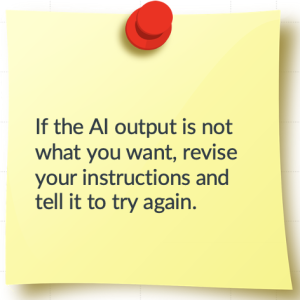10 ✨AI Courtroom Role Play – AI Enhanced Activity
This activity will help you understand the connection between argumentative essays and jury trials. You will select a topic, research it, and then role-play with AI as if you were in court, defending your position.
Instructions:
-
Study Argumentative Principles: Before starting this activity, review at least two of the following resources to understand the principles connecting argumentative essays to jury trials.

VR Simulation – This can be done with a VR headset OR on a computer, like a real estate tour. Click the hotspot arrows and videos to move around the courtroom and watch the videos. 
Sway – Scroll through the article style instruction and watch videos demonstrating courtroom roles. 
Handout – Read through the role comparison and disruptions on this Google Doc. -
Prepare Your Case: Prepare for the AI role-play and your upcoming essay by completing these steps:
- Select a Topic: Choose a topic for your essay with two clear sides. Decide which side you will argue.
- Research: Find at least three credible sources on your topic using the university’s online library resources.
- Analyze Sources: Read your sources carefully and identify quotes and paraphrases you can use as evidence.
-
AI Courtroom Role-Play: Follow these instructions to simulate a courtroom experience with AI using either Gemini or ChatGPT. You must be logged into an account (not using guest access) to generate a shareable link to the full chat log.
-
Initial Setup: Tell the AI to pretend it is a lawyer playing the opposite side (prosecution or defense) of your chosen position. Specify your position (prosecution or defense) and the topic.
“I’m preparing to write an argumentative essay on [topic]. I will be arguing for the [prosecution/defense] side. I’d like you to play the role of the lawyer for the opposing side ([defense/prosecution]).”
-
Opening Statements: Present context for your topic and state your main claim (thesis statement) to the AI, as if you were giving an opening statement. Prompt the AI to give its opening statement.
-
Presenting Evidence: Introduce evidence from your sources (quote or paraphrase with context) and explain how it supports your claim. This is like a body paragraph. Prompt the AI to challenge your evidence or offer counter-evidence.
-
Responding to Challenges: Respond to the AI’s challenges by clarifying your points or providing additional support from your sources. This may give you ideas for strengthening your essay paragraphs.
-
Repeat: Repeat the “Presenting Evidence” and “Responding to Challenges” process with at least two more pieces of evidence.
-
Closing Remarks: Deliver closing remarks that summarize your evidence and explain how it proves your case (like a concluding paragraph). Prompt the AI to give its closing remarks.
-
Feedback: Ask the AI for feedback on your arguments and how you could have improved. If any feedback is unclear, ask for clarification.
-

-
Submission:
- Sharable Chat Link: Create a shareable link to the entire AI conversation, showing all prompts and responses. Paste this link into the assignment submission area.
- Reflection: Separately, write a reflection (at least one well-developed paragraph) on your experience. Discuss how the role-play helped you prepare for your essay, what you learned from the AI’s feedback, and any other relevant insights. Include a discussion of the feedback given by the AI at the end of the exercise. Submit both the link and the reflection.
